Ryan Mendoza’s painting is comparable, in its proceeding, albeit in a different context, to the architecture by Alvar Aalto who, in designing a city, believed he had to start from a portion and not from the whole. The detail fascinates, intrigues; the zoom brings us up close, not so much to see the pores or hair, but only to exclude what is around the main subject in a disturbing position or that could cause distraction. Prolific art is the one that recalls theme after theme, figure after figure, cutting out what appears superfluous. Working on detail, focusing on cancellation: it is the anatomical drawing practice that easily transpires into collateral disciplines, which are dissociated from the original nucleus by parthenogenesis. For example, where the European protagonist of empirical rationalism, in focusing on detail, aimed at the entire earth’s surface with his heart, here ours aims at the entire skin of the painting, proceeding by molecules, by blocks, by themes, by insertions of antagonistic and autonomous segments. This painting, daughter of diaspora and dispersion, is in any case the fruit of a disposition to marvel that underlines the essential behind the most daring multiplicities. It is an articulated complex of nouns, verbs and adjectives: a complex that makes the image flex to its direct needs.
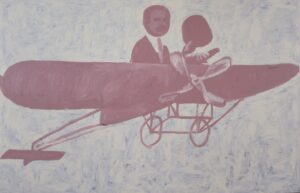
Ryan Mendoza, Man with hat in airplane, 1999, painting on canvas, cm 200 x 300, courtesy Massimo Minini, Brescia
In this continuous and modulated expressive freedom, the pictorial vertigo is transformed into a state of lightness that arises and comes to the surface effortlessly, to restore to NOTHING all the gravity, the horror, the desperation of a life not yet transformed into calm rapture. Yet this flesh that arises from the drawing and develops in the closure of the contour lines, is not so much a function of the portrait of a single person, it does not aim at the young lady next door (to be represented in the unmistakable specificity of the black shorts and the iris blue), but focuses on that particular transition towards the universal that characterizes every great renunciation of the particular and the anecdotal. In other words, we are in the presence of the sublime art of concision which, without wanting to be blasphemous, supports us with the paraphrase: “Let it be done, and it was done”. Circular path, of course, because in the return of things to themselves the idea of escape is not contemplated and the diaspora can only reveal itself as an ideological movement, almost of detachment, between body and body, between state and state of the human condition.
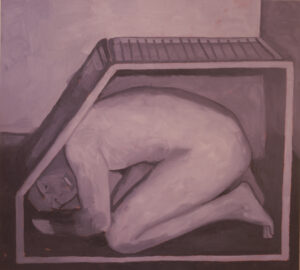
Ryan Mendoza, The cage, 2000, painting on canvas, courtesy Massimo Minini, Brescia
This greedy desire to incorporate images upon images and to search for continuous extra-pictorial references (for example in the cinematographic world), however perfectly inserted with the method of interlocking or a-dimensional superimposition, allows us to find fraternities, bringing the work of Ryan, intentionally, not only to the apotropaic walls of prehistoric man, but also to the “anthropophagous” world of David Salle. Signs that unite and envelop and erase those of the caves; secular and aseptic signs those of Salle, who, within a single pictorial plane, undertakes to compose (and contrast) disparate images and motifs, drawing inspiration from the mass media, from advertising, and even from the work of Courbet and Géricault.
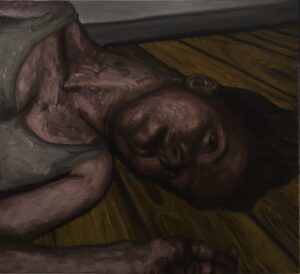
Ryan Mendoza, I love you therefore you are mine, 2010, painting on canvas, cm 141 x 145, Copyright: Ryan Mendoza. Photo: Fabia Zeyfang. Courtesy of the artist
However, although the attitude or propensity for fragmented composition can sometimes enter a similar route, the result is really completely dissimilar. Where primitive man “prayed” for his expiation, mixing color with blood, Salle “sews” (or “cooks”, if you prefer) in an aseptic way (fascinating but aseptic, that is, without getting his hands dirty). Finally, in the case of Mendoza the verb that must be used (and which alone gives us the idea of the action in its making) is “knead”. In his paintings, the author MIXES images with images, thus working on the most authentic and profound layers of painting, those that still have an evocative charm before being conceptual, beyond any media or technological projection; and always in a state of grace that we can trace back to a kiss placed sideways on the road to Damascus. A thought that is certainly obscure to most, but which we can easily unravel if we understand that a path always indicates a passage between two different points in space, whether they are mental or physical, it doesn’t matter. Just as the soldier Paulo, thanks to his blindness, became the proponent of a syncretism that united the shores of the Mediterranean, so Mendoza, in placing himself in the middle of that light, causes a backward conjugation that allows him to cut cleanly, from the our life, any falsely modernist inclination or declination. Here, then, is that the transit becomes a bridge of history: a necessary point of overcoming the current stagnation. And this happens when the chorus, in indicating an obligatory destination, pushes the hero to look beyond that path since he, in the absolute solitary gesture, has the ability to bring about even a reasonable hypothesis of compendium between the torn forces and decomposed in the field. So Paulo, so Ryan: both sewers of meanings, of transits, of mutations.
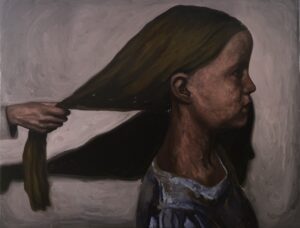
Ryan Mendoza, Necessary Limitations, 2010, painting on canvas, cm 147 x 188. Copyright: Ryan Mendoza. Foto: Fabia Zeyfang. Courtesy of the artist
In this way his painting, before becoming pigment, is innovative in thought, strong in invention and humble in construction. Innovative because it must go beyond the limit already set by the world around us, strong because it must have character, humble because it must breathe the wisdom of the craftsman. These three qualities the author welcomes all and, therefore, we have no objections to make. At the most, we allow ourselves to bring a few further annotations to our soliloquy. The rule that underlies all of Ryan Mendoza’s work does not claim to produce prayers, nor ascetic visions. Therefore it is not situated in that detachment from matter, from flesh and blood which can free the artist from his destiny: his is a painting of the shadow which in hindsight cannot submit to renunciation, so much so that external events press urgency to endanger it. More afraid of living than of dying, then, given that here the sacrifice obviously has a providential character: a symmetrical state that accepts the destiny of a predestined victim.
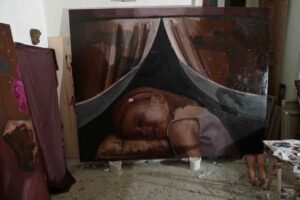
Ryan Mendoza, Studio shot, 2010. Copyright: Ryan Mendoza. Foto: Fabia Zeyfang. Courtesy l’artista
This does not mean being devoted to the ancient verb; it simply means being modern with the awareness that one’s roots cannot be betrayed: transgressing is possible, betraying really is not. And to transgress backwards today is to transgress twice. Therefore, the common thread that unites the sacred caves from the Paleotic age to the incorporations of Mendoza, passing gradually in rapid review through the “pittophagy” of modernity, cannot be broken; it can only be modified or put in tension: where our ancestors superimposed and erased by outlining the bodies in the profiles and in the mass of colour, now the bodies are given breath and the spaces are flattened, bringing the figures closer and squashing. The body, now, is all in the pigment, it is entirely enclosed within its vital soul, thus inverting the relationship between spirit and matter that has marked Western culture from the advent of Christianity onwards. This means that the beauty of matter is the light of its spirit that shines through on the outside, on the surface, and not vice versa.

Ryan Mendoza, Fingers, 2017, photographic print. Ph courtesy Spazio NEA, Napoli
If Mendoza’s creed is this inexorable river that creeps into the territory of being, then we need to find a way to overcome, to transcend “the carnal dispersion” which is also repeatedly emphasized to us by means of sensual bodies willing to make the utmost sacrifice or already sacrificed a moment before we were present. The river of painting divides the darkness, furrows them with the enchantment of its permanent flow, separating the ego from another ego, creating disagreement, discord or harmony; imposing a fracture that can only be resolved by blending into the noisy and restless current of modernity. The place of forgetfulness, the end of the univocal story, the breaking up of the threads and the reunion of these in an Edenic paradise do not belong to this thought, given that here we paint to heal ourselves. And for this we can only thank the author. Do we have any hope of being admitted to the forefront of this healing? Yes, but with difficulty, because we are, in any case, destined to remain on the threshold, to observe from the keyhole. It is then up to our sensitivity to practice this journey at a distance, a journey which however cannot be misleading: distance is also a movement of the spirit which can sometimes precede that of the body. Vitalism of tranquillity, one would say, if we wanted to coin a new oxymoron, so much so that the Bergsonian élan vital is contrasted here with a SILENT interpretation: every action represented seems to be suspended in a state of expectation, almost epochal must happen as a result of something more serious that has already happened. If we were dealing with photographic shots, it would be natural to talk about posing; since we are dealing with painted figures we will talk about the reincarnation of the permanence of time within an instinctive solitude.
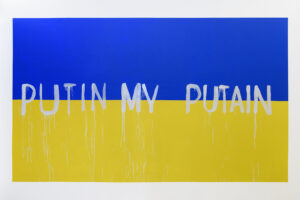
Ryan Mendoza, Putin my Putain/Ukraine Flag, 2020. Ph courtesy Spazio NEA, Napoli
Finally, I don’t think that Mendoza, from within his poetics, cares too much about symbolic meanings; he does not want to be tied to a hyperborean or hyperuranic tradition, nor to a sacredness of devotion. If there is sacredness, if there is devotion, these must be daughters of the Enlightenment, since his pictorial instinct (his narration through images) comes from the catastrophe of modernity stuck in the darkness of its multiple and sprawling laws. Mendoza, therefore, in the best way, is today more modern than Salle. Let’s be clear: they are both major authors, two unique in the art world, but while the second is inevitably consigned to the history from the eighties, the first is the purest and most articulated expression of the new Millennium; a millennium that is experiencing the endemic tragedy of terrorism and that still has difficulty understanding how any globalization must necessarily pass through the conservation of traditional transit nodes. A catchphrase could be added: circumcision artist, since the word sounds good; unfortunately this affirmation should be justified, and these are neither the most suitable time nor place. We will therefore settle for another closing sentence: return to the spirit (or to brotherhood) by means of the blood of painting.
(Ryan Mendoza is a painter of American origins, born on October 29, 1971, and lives between Naples and Berlin).
Roberto Vidali
Info:
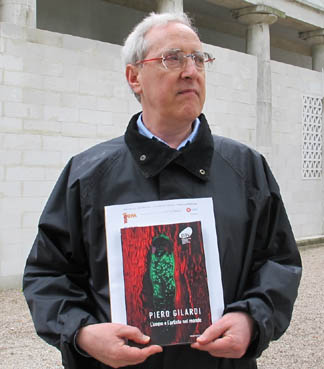
He is editorial director of Juliet art magazine.



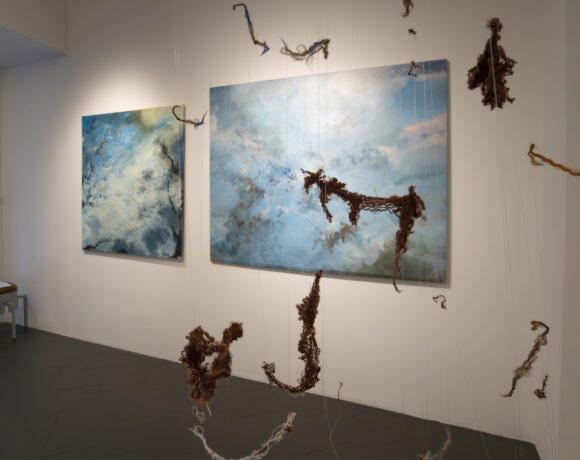
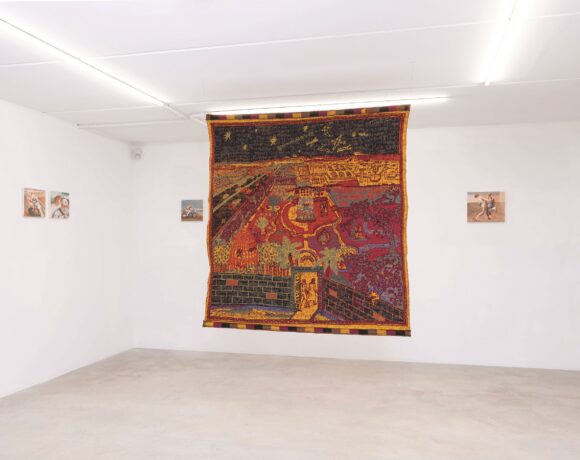

NO COMMENT